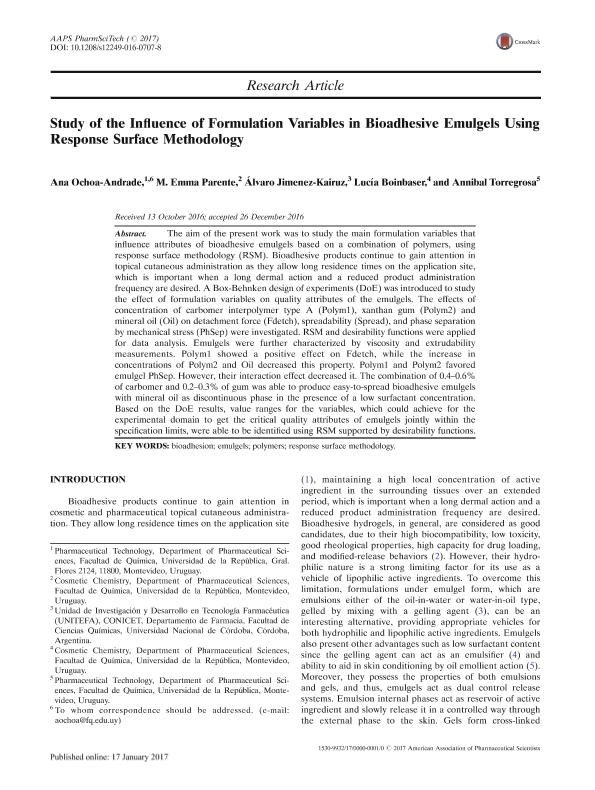Mostrar el registro sencillo del ítem
dc.contributor.author
Ochoa Andrade, Ana
dc.contributor.author
Parente, M. Emma
dc.contributor.author
Jimenez Kairuz, Alvaro Federico

dc.contributor.author
Boinbaser, Lucía
dc.contributor.author
Torregrosa, Annibal
dc.date.available
2018-12-03T14:46:25Z
dc.date.issued
2017-08-17
dc.identifier.citation
Ochoa Andrade, Ana; Parente, M. Emma; Jimenez Kairuz, Alvaro Federico; Boinbaser, Lucía; Torregrosa, Annibal; Study of the Influence of Formulation Variables in Bioadhesive Emulgels Using Response Surface Methodology; Springer; AAPS Pharmscitech; 18; 6; 17-8-2017; 2269-2278
dc.identifier.issn
1530-9932
dc.identifier.uri
http://hdl.handle.net/11336/65575
dc.description.abstract
The aim of the present work was to study the main formulation variables that influence attributes of bioadhesive emulgels based on a combination of polymers, using response surface methodology (RSM). Bioadhesive products continue to gain attention in topical cutaneous administration as they allow long residence times on the application site, which is important when a long dermal action and a reduced product administration frequency are desired. A Box-Behnken design of experiments (DoE) was introduced to study the effect of formulation variables on quality attributes of the emulgels. The effects of concentration of carbomer interpolymer type A (Polym1), xanthan gum (Polym2) and mineral oil (Oil) on detachment force (Fdetch), spreadability (Spread), and phase separation by mechanical stress (PhSep) were investigated. RSM and desirability functions were applied for data analysis. Emulgels were further characterized by viscosity and extrudability measurements. Polym1 showed a positive effect on Fdetch, while the increase in concentrations of Polym2 and Oil decreased this property. Polym1 and Polym2 favored emulgel PhSep. However, their interaction effect decreased it. The combination of 0.4–0.6% of carbomer and 0.2–0.3% of gum was able to produce easy-to-spread bioadhesive emulgels with mineral oil as discontinuous phase in the presence of a low surfactant concentration. Based on the DoE results, value ranges for the variables, which could achieve for the experimental domain to get the critical quality attributes of emulgels jointly within the specification limits, were able to be identified using RSM supported by desirability functions.
dc.format
application/pdf
dc.language.iso
eng
dc.publisher
Springer

dc.rights
info:eu-repo/semantics/openAccess
dc.rights.uri
https://creativecommons.org/licenses/by-nc-sa/2.5/ar/
dc.subject
Bioadhesion
dc.subject
Emulgels
dc.subject
Polymers
dc.subject
Response Surface Methodology
dc.subject.classification
Otras Ciencias Químicas

dc.subject.classification
Ciencias Químicas

dc.subject.classification
CIENCIAS NATURALES Y EXACTAS

dc.title
Study of the Influence of Formulation Variables in Bioadhesive Emulgels Using Response Surface Methodology
dc.type
info:eu-repo/semantics/article
dc.type
info:ar-repo/semantics/artículo
dc.type
info:eu-repo/semantics/publishedVersion
dc.date.updated
2018-10-22T19:34:35Z
dc.journal.volume
18
dc.journal.number
6
dc.journal.pagination
2269-2278
dc.journal.pais
Alemania

dc.journal.ciudad
Berlin
dc.description.fil
Fil: Ochoa Andrade, Ana. Universidad de la República; Uruguay
dc.description.fil
Fil: Parente, M. Emma. Universidad de la República; Uruguay
dc.description.fil
Fil: Jimenez Kairuz, Alvaro Federico. Consejo Nacional de Investigaciones Científicas y Técnicas. Centro Científico Tecnológico Conicet - Córdoba. Unidad de Investigación y Desarrollo en Tecnología Farmacéutica. Universidad Nacional de Córdoba. Facultad de Ciencias Químicas. Unidad de Investigación y Desarrollo en Tecnología Farmacéutica; Argentina
dc.description.fil
Fil: Boinbaser, Lucía. Universidad de la República; Uruguay
dc.description.fil
Fil: Torregrosa, Annibal. Universidad de la República; Uruguay
dc.journal.title
AAPS Pharmscitech

dc.relation.alternativeid
info:eu-repo/semantics/altIdentifier/doi/https://dx.doi.org/10.1208/s12249-016-0707-8
dc.relation.alternativeid
info:eu-repo/semantics/altIdentifier/url/https://link.springer.com/article/10.1208/s12249-016-0707-8
Archivos asociados
